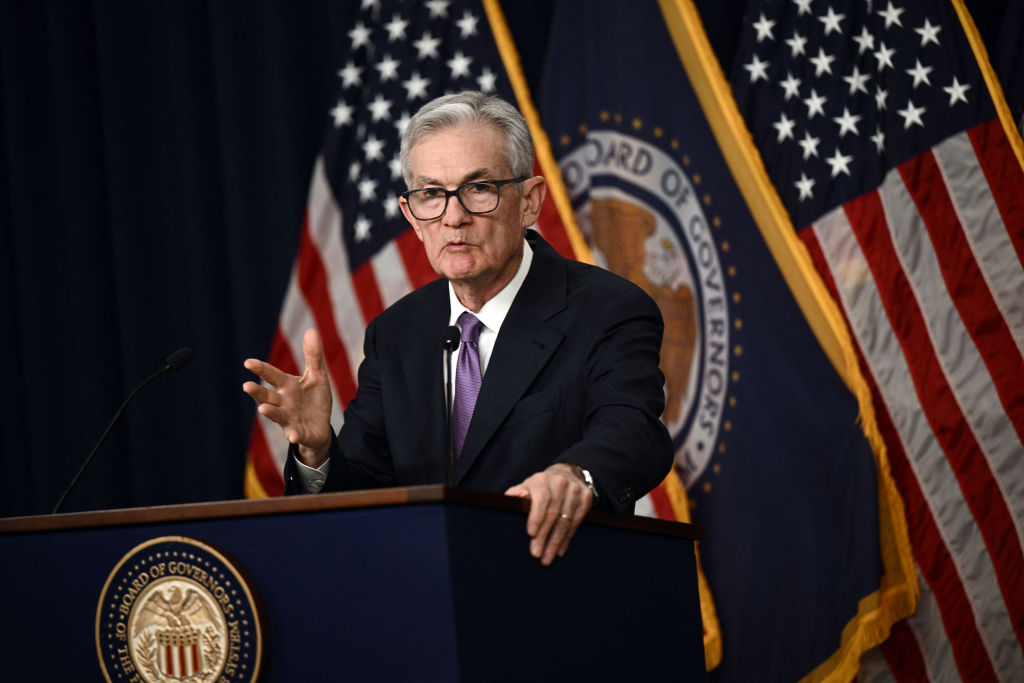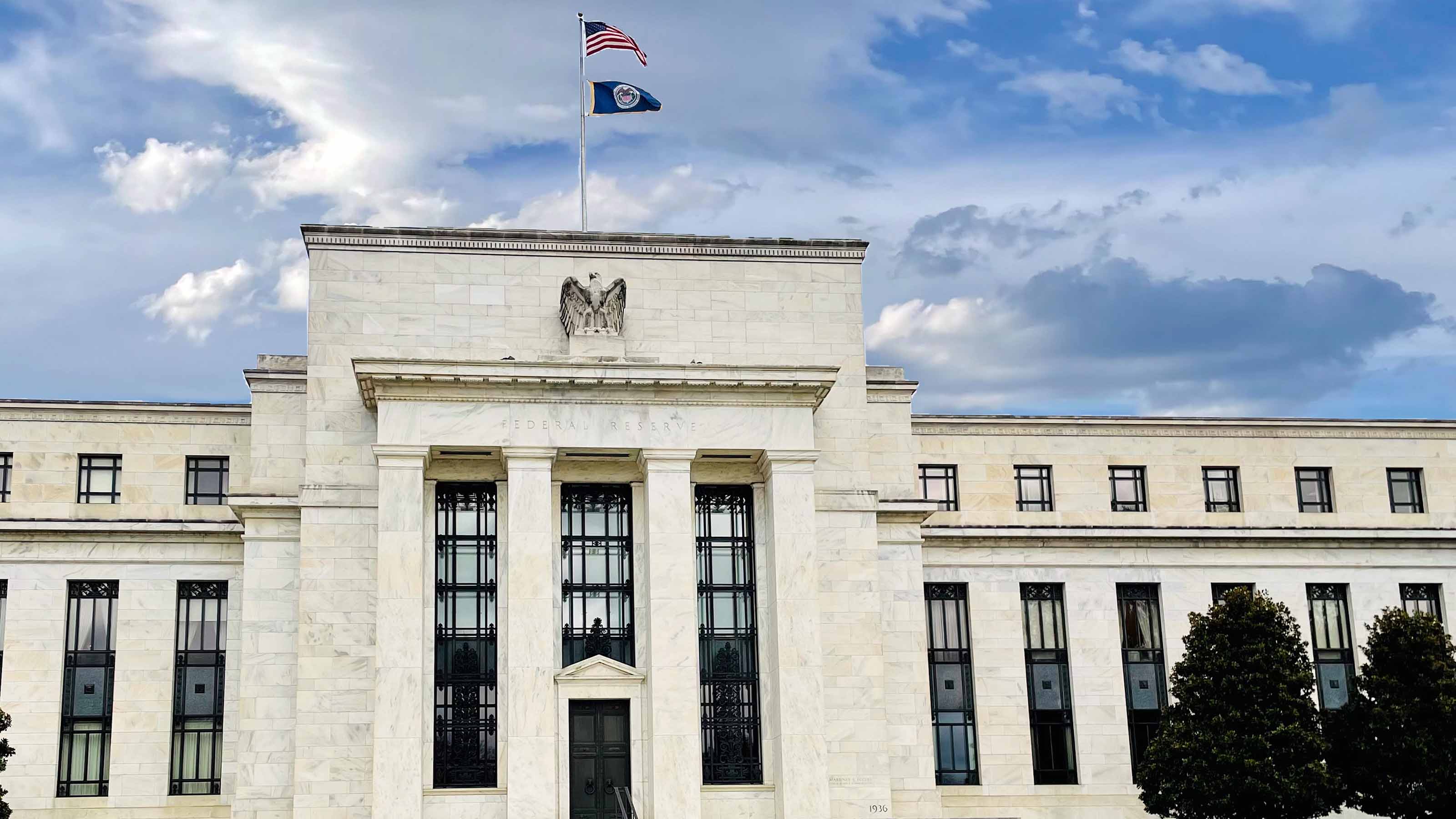Fed Holds Rates Steady at 23-Year High: What the Experts Are Saying
The Federal Reserve struck a dovish pose even as it kept interest rates unchanged for a sixth straight meeting.


The Federal Reserve made the widely expected move of leaving interest rates unchanged for a sixth straight meeting, citing a "lack of further progress toward its 2% inflation target." Equity investors celebrated nonetheless, as the Fed chief declined to take a more hawkish posture on rates going forward.
While the Fed's "higher-for-longer" stance on interest rates was already reflected in share prices, stocks perked up on some dovish remarks from Fed Chair Jerome Powell in his post-meeting press conference. Markets particularly liked the fact that the Fed chief said the possibility of rate increases was remote.
"After seeing disinflationary momentum stall in recent months, investors had braced themselves for a more hawkish tone from the Fed at this meeting," says Adam Phillips, managing director of investments at EP Wealth Advisors. "However, the prepared statement and press conference that followed painted a more optimistic view of the current economic backdrop and led to a sharp rally in both equities and fixed income."

Sign up for Kiplinger’s Free E-Newsletters
Profit and prosper with the best of expert advice on investing, taxes, retirement, personal finance and more - straight to your e-mail.
Profit and prosper with the best of expert advice - straight to your e-mail.
For the record, the Fed's Federal Open Market Committee (FOMC) left the short-term federal funds rate steady at 5.25% to 5.5% when it wrapped up its regularly scheduled two-day policy meeting on Wednesday. What traders and investors really want to know is when the FOMC will begin easing – a timeline that keeps getting pushed back.
Indeed, market participants forecast as many as seven quarter-point rate hikes heading into 2024. As recently as March, the FOMC penciled in three cuts before year-end. But a series of sticky inflation prints has complicated the Fed's plans. Futures traders now forecast just one quarter-point rate cut before the year is out, according to CME Group's FedWatch Tool.
With the FOMC's latest rate decision now on the books, we turned to economists, strategists and other pros for their thoughts on what the move means for markets, macroeconomics and monetary policy going forward. Please see a selection of their commentary, sometimes edited for brevity or clarity, below.
Interest rates: the experts weigh in

"The Fed left rates on hold, as universally expected. The statement contains no hawkish pivot in tone or any explicit reference to increasing interest rates in future. We see nothing in the statement that will prevent the Fed from pivoting to reducing interest rates multiple times this year if, as we expect, growth in payrolls slows considerably in Q2 and month-to-month increases in the core PCE deflator revert to last year's moderate pace." – Ian Shepherdson, chairman and chief economist at Pantheon Macroeconomics
"In our view, the entirety of this meeting was far more dovish than markets were clearly priced for, and that all told there remains an easing bias at the Fed under nearly all reasonable scenarios. The addition of language which confirmed the 'lack of further progress' on inflation in recent months was on its own hawkish, it was offset by updated language stating that the balance of risks around inflation are now balanced, or that the risks of higher inflation are matched by chances that disinflationary progress continues." – Tom Garretson, senior portfolio strategist at RBC Wealth Management
"There are two groups of people: those who don't know where interest rates are going, and those who don't know that they don't know where interest rates are going. Powell is in the first camp. He has consistently said the Fed is data-dependent. We believe that one rate cut in 2024 is more realistic given the persistent inflation that we see, still far off from the Fed's ultimate goal of 2%. We are confident that if the labor market were to see marked weakness, the Fed would begin to cut rates faster." – Eric Diton, president and managing director of The Wealth Alliance
"Today's decision by the FOMC to hold rates steady was no surprise and the Fed has warned market participants that hotter-than-expected inflation data during Q1 means rates will likely stay higher for longer. Consumer confidence is at its lowest level since mid-2022, though, and our own Citizens Business Conditions Index showed company revenue dipping in Q1. The labor market and the economy have been resilient. The Fed will have to balance a slowing economy and inflation above its target level." – Eric Merlis, managing director and co-head of global markets at Citizens
"Powell repeatedly refused to entertain the idea of more rate hikes from here and swatted away the idea of stagflation, pointing out that inflation has eased a lot and the unemployment rate is really low. In his view, he thinks inflation will continue to ease, so the next likely move by the Fed will be a rate cut once they get enough confidence that inflation is headed to 2%." – Sonu Varghese, global macro strategist at Carson Group
"The Fed is still in wait-and-see mode before they get dovish. But the data hasn't been cooperating. This statement keeps investors data dependent and focused on April numbers, such as the Consumer Price Index (CPI) two weeks from now." – David Russell, global head of market strategy at TradeStation
"U.S. growth and inflation exceptionalism in the first quarter suggest the Fed will exercise patience before pivoting to rate cuts, spending the second quarter regaining confidence on disinflation. We expect the downtrend in inflation has been delayed, not derailed. As for the Fed's balance sheet reduction, today's decision to taper quantitative tightening is a nod to liquidity considerations in the financial system, rather than a shift in direction. Nonetheless, we are taking a cautious approach to U.S. rates until we see clear signs of progress tackling inflation." – Whitney Watson, global co-head and co-chief investment officer of fixed income and liquidity solutions within Goldman Sachs Asset Management
"The Fed has been clear that it will continue to 'kick the can' on interest rates until it's confident inflation is under control, but let's not forget there are a number of tools the Fed can use outside of setting interest rates. For investors, it's hard to bet on anything here given competing data points on inflation, output and confidence. It's now about managing risk within portfolios as we wait and see." – Jason Barsema, president and co-founder of Halo Investing
"As we get closer to election season, the Fed is less likely to make any changes to rates, which means there's a chance we might be in this high-rate environment until 2025. It's 'when', not 'if,' the Fed is going to cut rates, but since the timeline for cuts has been pushed out beyond previous forecasts, consumers need to brace themselves for a prolonged high-rate environment." – Frank Lietke, executive director and president at Ally Invest Securities
"After a string of higher-than-expected inflation data, the Fed had no choice but to maintain their narrative of keeping rates higher-for-longer, keeping the fed funds rate unchanged. Add to this a strong economy and loose financial conditions, the Fed is compelled to sound hawkish at today's press conference. I do not expect the Fed to cut rates until it gains confidence that inflation is moving sustainably toward their 2% target level. Post the FOMC statement, investor expectations have now adjusted to just one rate cut for 2024 – this contrasts with expectations of six rate cuts earlier this year. The first rate cut could likely occur in December." – Rajeev Sharma, managing director of fixed income investments at Key Private Bank
"The Fed has been surprised and humbled by the persistent inflation data and the resilience of the economy and consumer. The Fed has been consistent in that they are resigned to take action only as the data dictates. The economy has plenty of tailwinds to further delay support for rate cuts: strong labor market and solid economic growth (plenty of cash on corporate balance sheets, rising corporate stock buybacks, $3.8 trillion in cash on sidelines, potential of AI to create next stage of growth) and to withstand higher rates for longer. Some wildcards that could pivot their current stance – tariffs, a significant rise in consumer wages/further tightening of the labor market – singularly or collectively have the probability of moving rate cuts into 2025." – Kathleen Grace, managing member and CEO of Fiduciary Family Office
Related Content
Get Kiplinger Today newsletter — free
Profit and prosper with the best of Kiplinger's advice on investing, taxes, retirement, personal finance and much more. Delivered daily. Enter your email in the box and click Sign Me Up.

Dan Burrows is Kiplinger's senior investing writer, having joined the august publication full time in 2016.
A long-time financial journalist, Dan is a veteran of MarketWatch, CBS MoneyWatch, SmartMoney, InvestorPlace, DailyFinance and other tier 1 national publications. He has written for The Wall Street Journal, Bloomberg and Consumer Reports and his stories have appeared in the New York Daily News, the San Jose Mercury News and Investor's Business Daily, among many other outlets. As a senior writer at AOL's DailyFinance, Dan reported market news from the floor of the New York Stock Exchange.
Once upon a time – before his days as a financial reporter and assistant financial editor at legendary fashion trade paper Women's Wear Daily – Dan worked for Spy magazine, scribbled away at Time Inc. and contributed to Maxim magazine back when lad mags were a thing. He's also written for Esquire magazine's Dubious Achievements Awards.
In his current role at Kiplinger, Dan writes about markets and macroeconomics.
Dan holds a bachelor's degree from Oberlin College and a master's degree from Columbia University.
Disclosure: Dan does not trade individual stocks or securities. He is eternally long the U.S equity market, primarily through tax-advantaged accounts.
-
 6 Stunning Waterfront Homes for Sale Around the US
6 Stunning Waterfront Homes for Sale Around the USFrom private peninsulas to lakes, bayous and beyond, Kiplinger's "Listed" series brings you another selection of dream homes for sale on the waterfront.
By Charlotte Gorbold Published
-
 Six Reasons to Disinherit Someone and How to Do It
Six Reasons to Disinherit Someone and How to Do ItWhether you're navigating a second marriage, dealing with an estranged relative or leaving your assets to charity, there are reasons to disinherit someone. Here's how.
By Donna LeValley Published
-
 Should You Still Wait Until 70 to Claim Social Security?
Should You Still Wait Until 70 to Claim Social Security?Delaying Social Security until age 70 will increase your benefits. But with shortages ahead, and talk of cuts, is there a case for claiming sooner?
By Evan T. Beach, CFP®, AWMA® Published
-
 Retirement Planning for Couples: How to Plan to Be So Happy Together
Retirement Planning for Couples: How to Plan to Be So Happy TogetherPlanning for retirement as a couple is a team sport that takes open communication, thoughtful planning and a solid financial strategy.
By Andrew Rosen, CFP®, CEP Published
-
 Market Turmoil: What History Tells Us About Current Volatility
Market Turmoil: What History Tells Us About Current VolatilityThis up-and-down uncertainty is nerve-racking, but a look back at previous downturns shows that the markets are resilient. Here's how to ride out the turmoil.
By Michael Aloi, CFP® Published
-
 How to Get Apple TV Plus for just $2.99
How to Get Apple TV Plus for just $2.99For a limited time, you can get three months of Apple TV Plus for just $2.99 per month. Here’s how to get the deal.
By Rachael Green Published
-
 Stock Market Today: Stocks Surge to Close a Volatile Week
Stock Market Today: Stocks Surge to Close a Volatile WeekIt was another day with a week's worth of both news and price action, but it ended on a strongly positive note.
By David Dittman Published
-
 Don’t Panic About the “Retail Blackout” – See Which Stores Are Closing (and Which Aren’t) for Easter 2025
Don’t Panic About the “Retail Blackout” – See Which Stores Are Closing (and Which Aren’t) for Easter 2025Dozens of major retailers are planning to close their doors on April 20. Find out which of your go-to stores are on the list.
By Rachael Green Published
-
 Home Insurance: How to Cut Costs Without Losing Coverage
Home Insurance: How to Cut Costs Without Losing CoverageNatural disasters are causing home insurance premiums to soar, but don't risk dropping your coverage completely when there are ways to keep costs down.
By Jared Elson, Investment Adviser Published
-
 Markets Roller Coaster: Resist the Urge to Make Big Changes
Markets Roller Coaster: Resist the Urge to Make Big ChangesYou could do more harm than good if you react emotionally to volatility. Instead, consider tax-loss harvesting, Roth conversions and how to plan for next time.
By Frank J. Legan Published